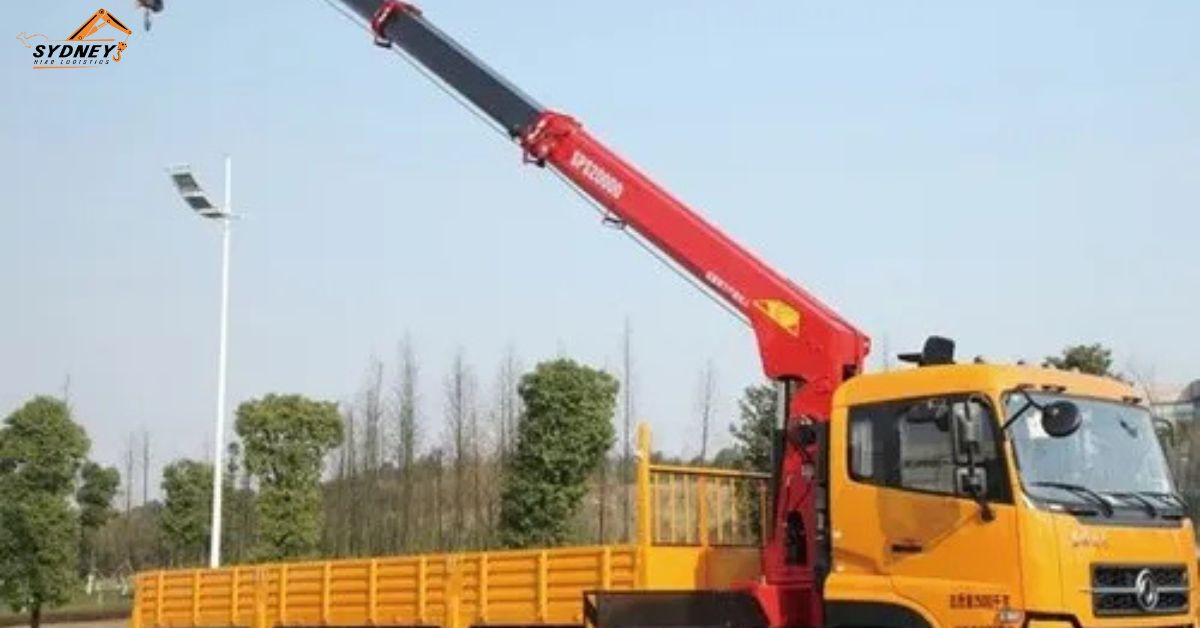In the fast-paced logistics industry, the necessity for emergency or last-minute material transportation can arise unexpectedly. Whether it’s an urgent requirement at a construction site or an unanticipated disruption in the supply chain, businesses need a dependable logistics partner to manage these critical situations effectively. In New South Wales (NSW),Sydney Hiab Logistics has established a strong reputation for its ability to swiftly respond to urgent demands with accuracy and dependability. Their cutting-edge solutions, state-of-the-art fleet, and customer-focused approach position them as the preferred choice for emergency transport requirements.
In this article, we will explore the significance of effective last-minute transportation, the distinct obstacles it poses, and how Sydney Hiab Logistics addresses these issues. Furthermore, we will emphasise the firm’s approaches, technologies, and case studies that demonstrate their proficiency in high-pressure situations.
1. The Importance of Emergency Material Transport
a. Critical to Business Continuity
Emergencies in logistics can have significant ramifications on business operations. A delay in delivering materials to a construction site, for example, can halt progress, leading to increased costs and missed deadlines. This can ripple through other phases of a project, delaying completion dates and affecting subsequent projects. Similarly, manufacturers may face production stoppages if critical components fail to arrive on time, disrupting supply chain schedules and affecting customer satisfaction. Emergency transport services act as a safeguard, ensuring that businesses can continue operations without major disruptions and keeping their commitments intact.
In a competitive environment, business continuity isn’t just about maintaining operations; it’s about ensuring that clients and stakeholders maintain confidence in a company’s ability to deliver under pressure. For industries such as healthcare or food services, delays in material or equipment delivery can directly impact lives, making reliable emergency transport an indispensable part of operational planning.
b. Supporting Unpredictable Demands
Unexpected site conditions, project modifications, or material shortages are common causes of abrupt material requirements in industries such as building and infrastructure development. Last-minute orders for steel beams, heavy gear, or building aggregates are typical, and delays can quickly inflate expenses. Having a logistics company that can respond swiftly ensures that these expectations are met, preventing downtime and keeping the project on track.
Emergency transportation is especially beneficial to businesses that deal with variable workloads or seasonal spikes. Agricultural farmers, for example, may demand fast delivery of goods during peak harvesting seasons, whereas event organisers may want last-minute setup materials. A proactive logistics service effectively bridges these gaps, eliminating costly delays and guaranteeing seamless operations even under high-pressure conditions.
c. Mitigating Supply Chain Disruptions
Unexpected disruptions, such as supplier delays, transportation mishaps, or natural calamities, can devastate supply chains and halt operations. Without a backup plan, businesses suffer extended downtime and financial losses. Emergency logistics solutions bridge this essential gap by offering quick response services that restore normalcy with minimal disruption to schedules.
Supply chain disruptions can occur from a variety of causes, including global catastrophes such as pandemics, localised weather disruptions, and internal operational failures. Businesses having emergency transportation options, such as those provided by Sydney Hiab Logistics, have a significant edge. They sustain flow by promptly resolving gaps and bottlenecks, avoiding cascade consequences that could damage downstream partners and customers.
Furthermore, emergency logistics enables organisations to manage unexpected demand shifts. Retailers facing unanticipated spikes, for example, can rely on quick delivery to replace vital items, ensuring customer happiness and preventing revenue losses.
d. Avoiding Financial Losses
Delays in material transit can result in considerable financial penalties, increased labor expenses, and reputational damage, especially in industries that rely on just-in-time inventory systems. Construction projects may face significant fines for missing deadlines, and industries may pay additional expenditures for idle equipment and labor. Emergency logistics solutions mitigate these obstacles by assuring timely deliveries, thus protecting a company’s financial line and market reputation.
For firms, the cost of unfilled contracts or missed client expectations sometimes outweighs the immediate costs of arranging last-minute logistics. A trusted transportation partner not only reduces these risks, but also enhances client relationships by ensuring continuity even under difficult conditions. Companies that avoid disruptions and financial failures can focus on growth and operational excellence without being hampered by logistical issues.
2. Challenges in Emergency or Last-Minute Transport
a. Time Sensitivity
The greatest issue in emergency transportation is the time constraint. Unlike normal delivery, emergency requests necessitate fast action, leaving no room for mistakes in planning or implementation. Logistics providers must have the ability to make timely decisions and allocate resources efficiently.
b. Navigating Traffic and Urban Constraints
In a busy state like New South Wales, traffic congestion, construction, and urban infrastructure can complicate transportation routes. To successfully manage these hurdles, emergency logistics requires thorough knowledge of the region as well as real-time data.
c. Handling Specialised Loads
Many emergency transport requirements include big or heavy materials. These loads necessitate specialised equipment, vehicles, and experience. Keeping up with safety rules while meeting tight schedules adds another element of complexity.
d. Availability of Resources
Emergency requests frequently arise outside of regular business hours, making it difficult to ensure the availability of drivers, vehicles, and equipment. A robust logistics infrastructure is required to fulfill these demands quickly.
e. Weather-Related Challenges
The unpredictable weather in New South Wales might make emergency transportation difficult. Heavy rains, flooding, and excessive heat all have an impact on road conditions and overall transportation efficiency. Having a logistics partner with contingency plans in place is essential.
3. How Sydney Hiab Logistics Excels in Emergency Transport
Sydney Hiab Logistics stands out as a reliable emergency transport partner in NSW because to its strategic strategy, cutting-edge resources, and experienced workforce. The following are the major ways they handle last-minute logistics well.
a. Rapid Response System
Sydney Hiab Logistics has implemented a streamlined rapid response system that allows them to act instantly upon receiving an emergency request.
· This system provides 24/7 availability for critical transportation needs.
· Dedicated Dispatch Team: A specialised team evaluates requests, finds needed resources, and sends vehicles quickly.
b. Advanced Fleet and Equipment
Sydney Hiab Logistics’ diversified fleet is built to carry a wide range of cargoes, including conventional cargo and large commodities. Features include:
1. Hiab Trucks with Hydraulic Cranes, which are ideal for transporting big or oddly shaped items.
2. Flatbed trucks are ideal for transporting huge building supplies fast.
3. GPS-equipped vehicles provide exact tracking and route optimisation.
c. Expertise in Route Planning
Navigating NSW’s complex road networks during an emergency requires advanced planning and local expertise. Sydney Hiab Logistics employs cutting-edge route optimisation tools that:
- Identify the Fastest Routes: Based on real-time traffic and weather conditions.
- Minimise Delays: By avoiding congested areas or road closures.
- Adapt in Real-Time: Adjusting as needed to ensure timely delivery.
Compliance with Regulations
Handling oversized or heavy loads in emergency situations requires strict adherence to safety and transportation regulations. Sydney Hiab Logistics ensures:
- Permits are Secured Quickly: For oversized loads, even at short notice.
- Safety Standards are Maintained: With trained operators and well-maintained equipment.
4. Technologies Driving Efficiency in Emergency Logistics
Sydney Hiab Logistics uses cutting-edge technology to provide dependable emergency transportation services. These include the following:
a. Real-time tracking and communication.
GPS monitoring devices provide real-time information on vehicle positions, enabling both the logistics staff and clients to track progress. Instant communication guarantees that any difficulties are addressed right away.
b. AI-Powered Route Optimisation
Artificial intelligence (AI) systems analyse traffic patterns, weather forecasts, and delivery requirements to determine the most effective routes, saving time and money.
c. Automated Dispatch System
These systems improve resource allocation by ensuring that the appropriate vehicle and equipment are deployed in a timely manner for each emergency call.
d. Digital documentation
Sydney Hiab Logistics manages permits, invoicing, and delivery confirmations through digital systems, which reduces administrative delays and increases efficiency.
e. Predictive Analytics
Sydney Hiab Logistics uses data analytics to anticipate supply chain problems and proactively plan for emergency scenarios, assuring uninterrupted service delivery.
5. Real-Life Scenarios: Sydney Hiab Logistics in Action
Case Study 1: Urgent Delivery of Construction Materials
A large construction job in Sydney had an unanticipated shortage of steel beams due to supplier delays. Sydney Hiab Logistics was approached late in the evening to transfer items from a warehouse 100 kilometers distant. Because of their 24-hour availability and thorough route planning, the delivery was accomplished in hours, avoiding any disruption on the site.
Case Study 2: Emergency Transport During Floods
During catastrophic flooding in remote NSW, a manufacturing business required immediate transfer of machinery to a different location. Sydney Hiab Logistics deployed a team of flatbed trucks and obtained the appropriate permissions for big loads. Despite the tough road conditions, the transportation was done safely and on time.
Case Study 3: Last-Minute Delivery of Event Equipment
Following the failure of their initial source to supply staging equipment, an event organiser in Sydney sought last-minute transport. Sydney Hiab Logistics responded quickly, using their Hiab trucks to load and deliver the equipment to the location within hours, ensuring that the event went as planned.
Case Study 4: Critical Hospital Equipment Delivery
A regional hospital in New South Wales requested emergency transport for life-saving medical equipment. Sydney Hiab Logistics responded quickly, ensuring that the equipment arrived securely and without delay, allowing the hospital to resume crucial operations.
6. Benefits of Partnering with Sydney Hiab Logistics for Emergency Transport
- Reliability: Clients can rely on Sydney Hiab Logistics to deliver materials on their schedule, even under demanding situations. Their solid track record demonstrates their dependability and commitment
- Flexibility: Sydney Hiab Logistics responds to each emergency’s unique requirements, providing personalised solutions that match the specific needs of clients.
- Transparency: Clients are kept informed at all stages of the transportation process thanks to real-time tracking and transparent communication, giving them piece of mind.
- Cost Efficiency: Sydney Hiab Logistics keeps costs down while delivering on time by employing innovative technologies and efficient operations.
- Expert Handling of Specialised Loads: Sydney Hiab Logistics’ fleet is built to handle a wide range of cargo types, ensuring the safe and efficient transfer of specialised or sensitive commodities, even in emergency situations.
7. Preparing for Future Challenges in Emergency Logistics
As industries evolve and the demand for fast logistics grows, Sydney Hiab Logistics continues to invest in:
• Expanding fleet with specialised vehicles to meet different transportation requirements.
• Implementing AI and machine learning tools to improve predictive analytics.
• Ensuring team proficiency in emergency response through training programs.
• Sustainability initiatives aim to reduce environmental impact and increase efficiency.
8. Practical Tips for Businesses Needing Emergency Transport
Emergency situations are common in areas such as construction, manufacturing, and healthcare. Companies can better prepare for such events by working with a reputable provider such as Sydney Hiab Logistics. Here are some useful tips:
a. Establish Clear Communication Channels
• Ensure essential contacts are always available for fast communication with the logistics provider.
• Ensure precise information about items, pickup location, and destination to avoid delays.
b.Plan for Contingencies
• Ensure vital supplies have an inventory buffer wherever possible.
• Find alternative suppliers and logistical providers to minimise disruptions.
c. Choose a Reliable Logistics Partner
• Collaborate with Sydney Hiab Logistics, a provider with 24/7 availability, specialised equipment, and competence in emergency transportation.
•Check their track record, fleet capacities, and client feedback.
d. Utilise Technology
• Collaborate with suppliers who employ AI-powered technologies for route optimisation and predictive planning.
• Use digital documentation to streamline the process.
e.Train Your Team
• Educate internal workers on emergency logistical protocols to ensure quick response.
9. The Future of Emergency Logistics in NSW
As New South Wales expands and develops, so will the necessity for effective emergency logistics services. Sydney Hiab Logistics is prepared to tackle these challenges by remaining current with industry changes and customer expectations.
a. Integration of Advanced Technologies
1. Blockchain technology can improve supply chain transparency and security.
2. AI and machine learning will play a greater role in predictive logistics, anticipating and addressing possible disruptions before they happen.
b. Sustainable practices
Sydney Hiab Logistics aims to reduce its environmental impact by using eco-friendly cars and optimising fuel use. Collaborating with clients on green initiatives will also help achieve sustainability goals.
c. Customised Solutions
• The company seeks to offer personalised solutions for various industries, such as healthcare and events.
• Sydney Hiab Logistics will be able to handle more complicated and diverse loads with increased fleet specialisation.
d. Strengthened Collaboration
• Collaborating with local councils and emergency services can improve preparedness for large-scale events, like natural disasters or infrastructure failures.
• Improved collaboration with suppliers and logistics providers for faster response times and higher service quality.
Conclusion: Your Partner in Urgent Logistics
Sydney Hiab Logistics has established itself as the premier provider of emergency and last-minute material transportation in New South Wales. With an uncompromising commitment to dependability, efficiency, and client satisfaction, they have established the gold standard for excellence in this crucial industry.
Sydney Hiab Logistics, with innovative technologies and a professional and responsive workforce, assures that businesses can rely on them for flawless emergency transit services. They remain a valued partner for businesses in New South Wales by addressing unique difficulties and always evolving to meet future expectations.
Sydney Hiab Logistics is the name to know if you want peace of mind and guaranteed delivery even when things become hectic. Their skill, along with a thorough awareness of the local geography, makes them the best option for emergency material transport solutions. Contact Sydney Hiab Logistics today to discover the difference they make in urgent logistics.




